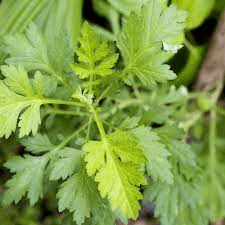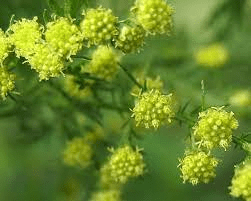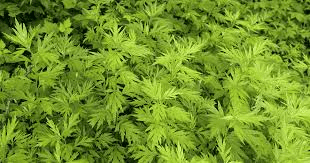Artemisia annua, commonly known as sweet wormwood or annual wormwood, is an herb native to Asia and has been used in traditional Chinese medicine for centuries. The plant belongs to the Asteraceae family and is characterized by its fern-like, finely divided leaves and yellow flowers.
One of the key components of Artemisia annua is artemisinin, a sesquiterpene lactone with antimalarial properties. Artemisinin and its derivatives, such as artesunate and artemether, are widely used in the treatment of malaria, a life-threatening mosquito-borne disease caused by Plasmodium parasites. Artemisinin-based combination therapies (ACTs) have become a cornerstone in the global effort to combat malaria, particularly in regions where drug-resistant strains have emerged.
The discovery of artemisinin’s effectiveness against malaria earned Chinese scientist Tu Youyou the Nobel Prize in Physiology or Medicine in 2015. Artemisinin works by disrupting the malaria parasite’s life cycle, particularly in its early stages.
Apart from its antimalarial properties, Artemisia annua has been investigated for potential anticancer, anti-inflammatory, and immunomodulatory effects. Research is ongoing to explore the full range of its therapeutic applications and to optimize its use in various medical contexts.
It’s worth noting that while Artemisia annua has demonstrated promising medicinal properties, its use should be approached with caution. The development of artemisinin resistance in malaria parasites is a concern, and proper medical guidance is crucial for the effective and responsible use of artemisinin-based therapies. Additionally, pregnant women or individuals with certain medical conditions should consult healthcare professionals before using products containing Artemisia annua.
The Botanical Description of Artemisia Annua
1. Plant Structure: Artemisia annua, commonly known as Sweet Wormwood or Annual Mugwort, is an herbaceous plant that belongs to the Asteraceae family. It typically reaches a height of 1 to 2 meters and is characterized by its upright, bushy growth.
2. Leaves and Foliage: The plant’s leaves are fern-like, deeply divided, and feathery in appearance. They are a vibrant green color and emit a distinctive aromatic fragrance when crushed.
3. Flowers: Artemisia annua produces small, inconspicuous flowers with a yellowish tint. These flowers are arranged in loose, branching clusters at the tips of the stems.
4. Stem and Bark: The stem of Artemisia annua is sturdy and erect, covered with fine, silvery hairs. The bark is smooth and can vary in color from green to reddish-brown.
5. Root System: The plant has a fibrous and shallow root system, spreading horizontally in the soil. While the roots play a role in anchoring the plant, the above-ground parts are more commonly utilized for medicinal purposes.
The Geographic Distribution of Artemisia Annua

1. Native Regions: Artemisia annua is native to temperate Asia, particularly areas of China and Southeast Asia. It has been cultivated and used in traditional medicine in this region for centuries.
2. Global Spread: Due to its medicinal properties, Artemisia annua has spread to other parts of the world and is now cultivated in various continents, including Europe, North America, and Africa.
3. Preferred Growing Conditions: The plant thrives in well-drained soils with adequate sunlight. It is often found in disturbed areas, along roadsides, and in fields.
4. Climate Suitability: Artemisia annua is well-adapted to a temperate climate but can also grow in subtropical and tropical regions. It is known to tolerate a range of environmental conditions.
5. Cultivation Practices: Cultivation of Artemisia annua has expanded globally, driven by the demand for its medicinal compound artemisinin. Various regions with suitable climates have adopted cultivation practices to meet the growing demand for this valuable herb.
The Chemical Composition of Artemisia Annua
1. Artemisinin: The primary bioactive compound in Artemisia annua is artemisinin, a sesquiterpene lactone with potent antimalarial properties. Artemisinin has become a key component in the treatment of malaria, contributing to global efforts to combat this infectious disease.
2. Essential Oils: The plant contains essential oils, which contribute to its characteristic aroma. These oils may have additional medicinal properties and are subject to extraction for various applications.
3. Flavonoids: Artemisia annua contains flavonoids, which are known for their antioxidant properties. These compounds may contribute to the plant’s overall health benefits.
4. Coumarins: Some varieties of Artemisia annua may contain coumarins, which are compounds known for their potential anticoagulant and anti-inflammatory effects.
5. Polysaccharides: The plant also contains polysaccharides, which play a role in various physiological processes and may contribute to the overall therapeutic effects of Artemisia annua.
Read Also: Worm Infestation on Ruminant Animals: Symptoms and Treatment
The Medicinal Health Benefits Of Artemisia Annua (Sweet Wormwood)

1. Antimalarial Properties: One of the most well-known and significant health benefits of Artemisia annua is its antimalarial properties, primarily attributed to the presence of artemisinin. This compound has revolutionized malaria treatment and has been instrumental in global efforts to combat the disease.
2. Anti-Inflammatory Effects: Artemisia annua contains compounds with anti-inflammatory properties, which can be beneficial in managing conditions characterized by inflammation, such as arthritis and inflammatory disorders.
3. Antioxidant Action: The plant’s components exhibit antioxidant effects, helping neutralize free radicals in the body. This antioxidant activity contributes to overall cellular health and may play a role in preventing oxidative stress-related conditions.
4. Immune System Modulation: Artemisia annua has been studied for its potential to modulate the immune system. This modulation may enhance the body’s natural defense mechanisms, promoting a more robust immune response.
5. Gastrointestinal Support: Some traditional uses of Artemisia annua involve gastrointestinal support. The plant may help soothe digestive issues and contribute to a healthy digestive system.
6. Fever Reduction: In traditional medicine, Artemisia annua has been employed to reduce fevers. This antipyretic property may be linked to its overall anti-inflammatory effects.
7. Respiratory Health: The plant may have positive effects on respiratory health, offering potential benefits for conditions such as asthma or respiratory inflammation.
8. Antiviral Activity: Preliminary research suggests that Artemisia annua may exhibit antiviral activity, opening avenues for exploring its role in combating certain viral infections.
9. Anti-Cancer Potential: Some studies have investigated the potential anti-cancer properties of Artemisia annua, particularly its effects on cancer cell growth. However, more research is needed to establish its efficacy in cancer treatment.
10. Menstrual Health Support: Traditional uses include the plant’s role in supporting menstrual health. It may help alleviate menstrual cramps and regulate menstrual cycles.
11. Liver Health: Artemisia annua has been studied for its potential hepatoprotective effects, indicating a positive impact on liver health.
12. Cardiovascular Support: The plant may offer cardiovascular support by contributing to heart health and promoting healthy circulation.
13. Neuroprotective Effects: Some research suggests that Artemisia annua may have neuroprotective effects, with potential benefits for neurological conditions.
14. Diabetes Management: Preliminary studies indicate that Artemisia annua may play a role in diabetes management, although further research is necessary to validate these findings.
15. Antibacterial Properties: Artemisia annua exhibits antibacterial properties, contributing to its traditional use in managing bacterial infections.
The Methods of Usage to Achieve the Provided Health Benefits Of Artemisia Annua (Sweet Wormwood)
1. Herbal Teas: One common method of using Artemisia annua is by preparing herbal teas. Infusing the leaves in hot water allows for a mild and palatable consumption, providing various health benefits.
2. Tinctures and Extracts: Creating tinctures or extracts from Artemisia annua allows for a concentrated form of the plant, facilitating precise dosage control for specific health goals.
3. Capsules or Tablets: Commercially available capsules or tablets offer a convenient and measured way to consume Artemisia annua, especially for those who may find the taste of the herb less appealing.
4. Infused Oils: Artemisia annua can be used to create infused oils, providing an option for topical applications, such as for skin conditions or wound healing.
5. Combined with Foods: Incorporating Artemisia annua into foods, such as salads or soups, offers an enjoyable way to include the plant in one’s diet.
6. Steam Inhalation: For respiratory benefits, steam inhalation using Artemisia annua can be effective. Inhaling the steam may help alleviate respiratory issues.
7. Poultices: Applying poultices made from Artemisia annua can be beneficial for localized effects, such as reducing inflammation or promoting wound healing.
8. Smoking Mixtures: In some traditional practices, dried Artemisia annua leaves are used in smoking mixtures, although this method is less common.
9. Combined with Other Herbs: Combining Artemisia annua with other herbs is a common practice to enhance or complement its effects, creating synergistic herbal blends.
10. Traditional Decoctions: Traditional decoctions involve boiling Artemisia annua in water to extract its medicinal properties. This method is often used in traditional medicine practices.
11. Ethnobotanical Rituals: In certain cultural contexts, Artemisia annua is used in ethnobotanical rituals for its potential psychoactive and spiritual significance.
12. Cold Water Extraction: Some users employ cold water extraction methods to minimize unwanted compounds while extracting beneficial ones.
13. Beverage Infusions: Creating infused beverages by steeping Artemisia annua in beverages like juice or fruit-infused water is a palatable way to consume the plant.
14. Syrups and Elixirs: Syrups and elixirs can be prepared using Artemisia annua, offering a sweetened form of consumption while retaining its health benefits.
15. Moderation in Usage: Regardless of the method chosen, moderation in usage is crucial to avoid potential side effects and ensure a balanced approach to health.
Understanding the various methods of usage for Artemisia annua allows individuals to choose an approach that aligns with their preferences and health goals.
The Side Effects Of Using Artemisia Annua Medicinal Plant
1. Allergic Reactions: Individuals with known allergies to Asteraceae family plants, including Artemisia annua, may experience allergic reactions. It is advisable to perform a patch test before widespread use.
2. Gastrointestinal Distress: Some users may experience gastrointestinal distress, such as nausea or diarrhea, especially when consuming high doses. Starting with lower doses can help mitigate these effects.
3. Neurological Symptoms: In rare cases, excessive consumption of Artemisia annua may lead to neurological symptoms, including dizziness or confusion. Monitoring for such symptoms is essential.
4. Photosensitivity: Artemisia annua may increase sensitivity to sunlight, leading to sunburn or skin reactions. Users should take precautions, such as using sunscreen, when exposed to sunlight.
5. Pregnancy and Lactation: Pregnant or lactating individuals should exercise caution and consult with a healthcare professional before using Artemisia annua, as its safety during these periods is not well-established.
6. Potential Drug Interactions: Individuals taking medications should be aware of potential drug interactions with Artemisia annua. Consulting with a healthcare provider is crucial to avoid adverse reactions.
7. Not Suitable for Prolonged Use: Long-term or excessive use of Artemisia annua may lead to cumulative effects, and users are advised to use the plant in moderation.
8. Psychoactive Effects: Certain varieties of Artemisia annua may contain compounds with psychoactive effects. Users should be aware of the potential psychoactivity and exercise caution, especially in sensitive individuals.
9. Liver Health Concerns: Some studies suggest that high doses of Artemisia annua may have implications for liver health. Individuals with pre-existing liver conditions should consult with a healthcare professional.
10. Quality of Plant Material: The quality of the Artemisia annua plant material can impact its safety and efficacy. Using reputable sources and ensuring proper identification is essential.
11. Legal Considerations: Users should be aware of the legal status of Artemisia annua in their region and adhere to relevant regulations to avoid legal complications.
Read Also: List of Diseases Ruminant Animals (Livestock) Get from Feeds and Water
The Scientific Research and Studies of Artemisia Annua

1. Antimalarial Efficacy: Numerous scientific studies have explored the antimalarial efficacy of Artemisia annua, particularly focusing on its key compound, artemisinin. Research has demonstrated the plant’s effectiveness in treating uncomplicated malaria, contributing significantly to global malaria control efforts.
2. Anti-Inflammatory Properties: Scientific investigations have delved into the anti-inflammatory properties of Artemisia annua. Studies suggest that the plant’s compounds may modulate inflammatory pathways, showcasing its potential in managing inflammatory conditions.
3. Antioxidant Activity: The antioxidant activity of Artemisia annua has been a subject of scientific interest. Research indicates that the plant’s components exhibit significant antioxidant effects, potentially aiding in reducing oxidative stress in the body.
4. Immunomodulatory Effects: Scientific research has explored the immunomodulatory effects of Artemisia annua, shedding light on its ability to influence the immune system. This research opens avenues for understanding its potential in enhancing immune responses.
5. Gastrointestinal Health: Studies have investigated Artemisia annua’s impact on gastrointestinal health. The plant’s traditional uses in addressing digestive issues align with scientific inquiries into its effects on the digestive system.
6. Neuroprotective Potential: Some scientific studies suggest that Artemisia annua may possess neuroprotective potential. Research in this area aims to uncover possible applications in neurodegenerative conditions.
7. Antiviral Properties: Scientific investigations into the antiviral properties of Artemisia annua have shown promise. Preliminary studies suggest its ability to combat certain viral infections, contributing to ongoing antiviral research.
8. Anticancer Research: The anticancer potential of Artemisia annua has been a focus of scientific exploration. While early studies indicate promising effects on cancer cells, further research is essential to determine its efficacy in cancer treatment.
9. Hepatoprotective Effects: Scientific studies have explored the hepatoprotective effects of Artemisia annua. Findings suggest a potential positive impact on liver health, emphasizing its role in traditional medicine.
10. Cardiovascular Studies: Some scientific research has investigated the cardiovascular effects of Artemisia annua. Understanding its influence on heart health contributes to a comprehensive assessment of its medicinal properties.
11. Antibacterial Activity: Studies exploring the antibacterial activity of Artemisia annua have identified its potential in managing bacterial infections, supporting its traditional uses.
12. Diabetes Management: Scientific inquiries into Artemisia annua’s role in diabetes management have yielded initial insights. Further research is needed to establish its effectiveness in this context.
The Safety Precautions and Recommendations In Using Artemisia Annua Medicinal Plant
1. Allergies and Patch Testing: Individuals with known allergies, especially to Asteraceae family plants, should exercise caution. Conducting a patch test before widespread use helps identify potential allergic reactions.
2. Dosage Moderation: Practicing moderation in dosage is crucial to avoid potential side effects. Starting with lower doses and gradually increasing under guidance can help ensure a balanced approach to usage.
3. Monitoring for Neurological Symptoms: Users should be vigilant for potential neurological symptoms, such as dizziness or confusion, especially with excessive consumption. Seeking medical attention for any adverse reactions is advised.
4. Photosensitivity Awareness: Artemisia annua may increase sensitivity to sunlight. Users should take precautions, such as using sunscreen, to protect against sunburn or skin reactions.
5. Pregnancy and Lactation Consultation: Pregnant or lactating individuals should consult with a healthcare professional before using Artemisia annua, as its safety during these periods is not well-established.
6. Potential Drug Interactions: Individuals taking medications should be aware of potential drug interactions with Artemisia annua. Seeking professional advice is crucial to prevent adverse reactions.
7. Limiting Prolonged Use: Long-term or excessive use of Artemisia annua may lead to cumulative effects. Users are advised to use the plant in moderation and under professional guidance.
8. Psychoactive Effects Caution: Certain varieties of Artemisia annua may contain compounds with psychoactive effects. Users should exercise caution, especially if sensitive to psychoactive substances.
9. Liver Health Considerations: Individuals with pre-existing liver conditions should consult with a healthcare professional, as high doses of Artemisia annua may have implications for liver health.
10. Quality of Plant Material: Using reputable sources and ensuring proper identification of Artemisia annua plant material is essential for its safety and efficacy.
FAQs About Artemisia Annua Medicinal Plant
1. Are there any legal restrictions on the use of Artemisia annua?
Legal considerations regarding Artemisia annua use may vary by region. Users should be aware of and comply with local regulations to avoid legal complications.
2. Can Artemisia annua be used as a substitute for conventional medications?
Artemisia annua should not be used as a substitute for conventional medications without consulting a healthcare professional. Its usage should complement standard medical treatments.
3. How long does it take to experience the effects of Artemisia annua?
The onset of effects can vary based on the method of consumption. Chewing the leaves or using concentrated forms may result in a quicker onset.
4. Is Artemisia annua safe for pregnant or lactating individuals?
Pregnant or lactating individuals should avoid using Artemisia annua due to limited research on its effects during pregnancy and breastfeeding.
5. Can Artemisia annua be addictive?
There is a potential risk of dependency with prolonged or excessive use of Artemisia annua. Users should practice moderation and be mindful of their consumption.
6. Are there specific contraindications for using Artemisia annua?
Individuals with pre-existing mental health conditions, allergies to Asteraceae family plants, or those taking medications should exercise caution and seek professional advice before using Artemisia annua.
7. What is the recommended dosage of Artemisia annua for medicinal purposes?
The recommended dosage can vary based on individual factors. Starting with a lower dose and gradually increasing while monitoring for effects is a common approach. Professional guidance is recommended.
8. Can Artemisia annua be combined with other herbs or supplements?
Combining Artemisia annua with other herbs or supplements should be done cautiously, considering potential interactions. Professional advice can help ensure safe combinations.
9. How can one mitigate potential side effects of Artemisia annua?
Mitigating potential side effects involves moderation in dosage, seeking professional guidance, and monitoring for adverse reactions. Discontinuing use if side effects occur is crucial.
10. Is it safe to drive or operate machinery after using Artemisia annua?
Due to potential psychoactive effects, it is not recommended to drive or operate machinery immediately after using Artemisia annua. Users should wait until they are no longer under its influence.
Read Also:





